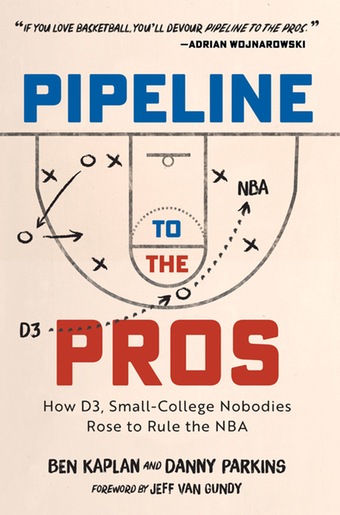| Pipeline to the Pros was released this week, just in time for the NBA playoffs. Photo by Ben Kaplan |
By Gordon Mann
When you’re a fan of something special outside the mainstream, you take personal pleasure when that special something gets props from the outside world.
“Oh, you like that band? I went to their shows when they were on the indie scene!”
“Oh, you like that hole-in-the-wall restaurant? We used to go there all the time for lunch!”
“Oh, you know that NBA basketball coach? He used to play Division III basketball!”

- Quintessential D3 Moment series introduction
- Sign up for the Kap Space newsletter
- Buy Pipeline to the Pros today!
Since you’re visiting our website at this point in the offseason, there’s a good chance you get a little shot of endorphin every time someone who coached or played Division III basketball appears on your television screen during the NCAA Division I basketball tournaments or NBA playoffs.
Hearing Jeff Van Gundy talk about his days at Nazareth during an NBA telecast or seeing Duncan Robinson listed as the national Division III rookie of the year provides those little jolts of joy. But the best coverage of Division III basketball does more than prick the “I recognize that reference!” pleasure gland.
The best coverage treats Division III athletics with enough respect to cover it honestly, thoughtfully and without over reliance on rags-to-riches” clichés. The best coverage is insightful, well-rounded, and entertaining. And it often comes from someone with firsthand Division III basketball experience.
That’s the type of coverage you’ll find in Pipeline to the Pros: How D3, Small-College Nobodies Rose to Rule the NBA by Ben Kaplan and Danny Parkins.
Over the last couple months, we’ve run short pieces from Kaplan, who describes himself as a “proud former D3 benchwarmer.” Kaplan played for Amherst in 2009, while also working for the College’s sports information department and blogging for our website.
He’s returned to D3hoops.com to share quintessential Division III moments from some of our most famous alumni – Shaka Smart, Brad Stevens, Duncan Robinson – and others whom the more casual NBA fan may not realize started at this level.
We’ve teased the release of Pipeline to the Pros in those columns and now you can now order the book for delivery.
In their book, Kaplan and Parkins adeptly shift between different modes of writing, zooming in on personal stories of former Division III basketball coaches and players who reached the NBA, and then zooming back out again to put those stories in the context of the NBA’s development as a league and a business.
The book is partially a historical survey, laying out chronologically how NBA coaching and front office jobs have evolved over the last 70 years, starting with the early history of the Minneapolis Lakers whose success and survival as a franchise was driven largely by a couple of MIAC alums.
The book is partially a long-form feature story, describing how two different coaching trees – one from the Van Gundy brothers and the other from Gregg Popovich – grew into a grove of D3 alums in NBA coaching and General Manager roles.
And it’s partially a biography with interstitial segments that trace Andrew Olson’s journey from a high school hoopster in San Diego to Division III national champion at Amherst, and eventually to NBA shooting coach.
Kaplan and Parkins write with a clear respect and affection for Division III basketball, and they do not let that affection devolve into hagiography or a repetitious repackaging of “if-you-can-dream-it-you-can-achieve-it” mythology.
Where appropriate, losing records, failed ventures and personal flaws get mentioned as part of a person's overall success story. If one of the featured characters rose to prominence because of less inspiring factors – a famous father, a lucky break, changing racial dynamics – then that gets equal time and honest evaluation.
Best of all, Kaplan and Parkins use their book to actually answer the question how did Division III alumni become more prominent in the NBA. They respect the reader enough not to ask that question just as a rhetorical device. They ask that question and then answer it in a way that’s entertaining and educational, even including bar graphs to chart how the percentage of NBA coaches and GMs with Division III backgrounds changed over time.
Kaplan and Parkins do all that while still giving enough nods to Division III basketball’s unique history so D3 hoop diehards will get little bursts of pleasure from reading the name of a coach, player, or program whose success they enjoy with a degree of personal pride, because they’ve discovered something special outside the mainstream.
There’s personal validation that comes from seeing something in which you’ve invested yourself reach the highest level of success -- when the indie band that you loved when they played at the corner coffee house becomes the headlining act at the nearest sports arena.
Pipeline to the Pros gives Division III basketball a bigger stage to shine and then delivers an entertaining show for diehards and D3 newcomers alike.
